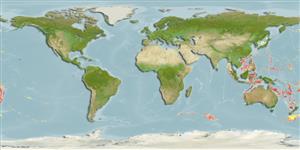Teleostei (teleosts) >
Gadiformes (Cods) >
Macrouridae (Grenadiers or rattails)
Etymology: Ventrifossa: Latin, venter, ventris = belly + Latin, fosa = pit (Ref. 45335).
Eponymy: Dr Yuriya (also spelled Yurii) Igorevich Sazonov (1950–2002) was a Russian ichthyologist, marine biologist and botanist at the Marine Biological Laboratory, Department of Ichthyology, Zoological Museum, who graduated from Moscow State University [...] (Ref. 128868), visit book page.
More on authors: Iwamoto & Williams.
Environment: milieu / climate zone / depth range / distribution range
Ecology
Marine; bathydemersal; depth range 420 - 886 m (Ref. 35909). Deep-water
Western Pacific: South China Sea and northern Australia (including Western Australia).
Size / Weight / Age
Maturity: Lm ? range ? - ? cm
Max length : 34.0 cm TL male/unsexed; (Ref. 35909)
Dorsal spines (total): 2; Anal spines: 0. Pelvic fin rays 9-10; second spinous ray of first dorsal fin with smooth leading edge; a well marked median nasal streak; chin barbel dark, length 17-24% of head length; outer premaxillary teeth notably larger than teeth of inner band; dorsum not strongly demarcated in color from rest of body in preserved specimens; suborbital shelf narrows anteriorly, somewhat constricted at anterior end.
A benthic species found on the continental slope (Ref. 75154).
Life cycle and mating behavior
Maturity | Reproduction | Spawning | Eggs | Fecundity | Larvae
Iwamoto, T. and A. Williams, 1999. Grenadiers (Pisces, Gadiformes) from the continental slope of western and northwestern Australia. Proc. Calif. Acad. Sci. 51(3):105-243. (Ref. 35909)
IUCN Red List Status (Ref. 130435: Version 2024-2)
Threat to humans
Harmless
Human uses
Tools
Special reports
Download XML
Internet sources
Estimates based on models
Preferred temperature (Ref.
123201): 2.3 - 10.2, mean 7.7 °C (based on 276 cells).
Phylogenetic diversity index (Ref.
82804): PD
50 = 0.5000 [Uniqueness, from 0.5 = low to 2.0 = high].
Bayesian length-weight: a=0.00214 (0.00109 - 0.00421), b=3.20 (3.03 - 3.37), in cm total length, based on LWR estimates for this (Sub)family-body shape (Ref.
93245).
Trophic level (Ref.
69278): 3.7 ±0.5 se; based on size and trophs of closest relatives
Resilience (Ref.
120179): Low, minimum population doubling time 4.5 - 14 years (Preliminary K or Fecundity.).
Fishing Vulnerability (Ref.
59153): Low vulnerability (24 of 100).
